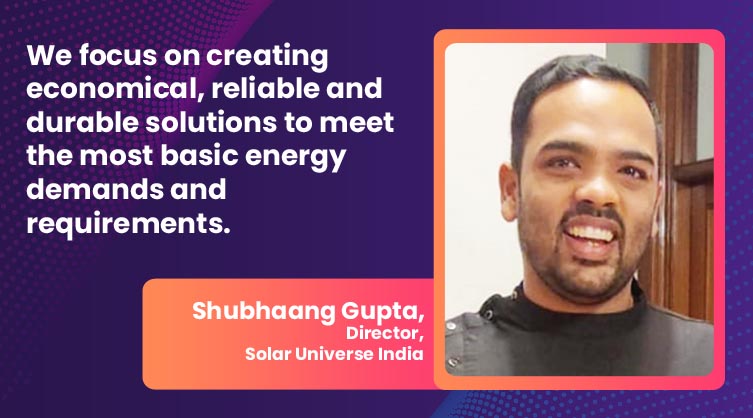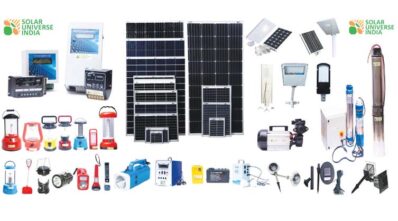Off-grid solar systems and products dominate the residential segment beyond urban India
By EPR Magazine Editorial November 25, 2022 12:24 pm IST
By EPR Magazine Editorial November 25, 2022 12:24 pm IST

Highlighting the trends in off-grid solar systems, Shubhaang Gupta, Director of Solar Universe India, explains how their innovations and economical offerings are making them a prominent solar company in the residential segment.
How are current energy trends influencing India’s demand for Off-grid solar systems?
The availability of energy in a given region determines society’s standard of living and progress. As the penetration of grid electricity increases and reaches tier 3 and 4 cities, there will be a slight fall in demand for smaller off-grid products such as solar lamps and torch lights. Still, the need for other off-grid products such as solar panels, batteries, inverters, and charge controller units will increase tenfold as the standard of living and per capita incomes increase. The idea behind this is that people at the bottom of the pyramid need the smaller appliances to carry out their daily chores away from their homes, on their farmlands, which are impossible to connect to the grid due to their distance from the substations in nearby semi-urban areas.
Most households have storage batteries with a life expectancy of 3 years or more that they recharge via the most democratic source of energy: THE SUN, also known as solar energy. We have seen YoY growth of 35–40 percent in the sales of solar panels, batteries, and charge controllers from Tier 2, Tier 3, and Tier 4 cities since 2017. This still excludes many towns in the northeast, east, south, and north of India that are not served by courier companies and must order their solar products for delivery close to cities with internet cafés. As pin code coverage increases, the demand for off-grid solar products will only increase until it reaches its saturation point due to grid penetration, which may take another ten years.
Which products and equipment are primarily used to maintain an efficient power supply in these solar systems?
A charge controller and inverter are at the heart of any off-solar product or system, with battery storage acting as the brain and solar panels acting as the gut. This equipment is common to all off-grid solar products; however, the technology, size, and deliverable features vary depending on the product’s ultimate use.

Due to technological advancements, conventional lead-acid batteries are now being replaced by ferrous lithium batteries, which have longer life cycles, are portable, and have better disposal mechanisms. Solar panels are also becoming more efficient every year. In 2017, a 6×3-foot panel produced 320 watts, and now the same panel is producing 450W. Charge controllers and integrated circuits are becoming more digitally controlled and efficient. An ALTO is not the same as a BMW, which differentiates our products from the rest of the products on the market. There is always room for more efficient technologies to deliver longer life cycles and better features. We have achieved a feat due to the years and money we have spent in R&D and innovation since the inception of the brand in 2003 and the ultimate breakeven in 2009.
What are the advantages and disadvantages of having off-grid solar installed?
Every technology has its pros and cons. However, off-grid solar has only one con: the recurring maintenance cost of the battery and storage system. Since off-grid systems rely on an auxiliary unit to store the solar energy derived during the day, the auxiliary unit, i.e., the battery, comes with specific and finite life cycles.
One of the most significant advantages of off-grid solar is that it functions even during power cuts and in areas with irregular power supplies, based on their energy spending.
Financial access and consumer awareness are the other two key challenges we’ve faced since we started. And they only got better to a limited extent. Banks are not willing to finance or extend loans to people in rural areas due to their existing exposure to financing their agricultural incomes.
We have now tied up with two NBFCs who have committed a large corpus of collateral-free funds for the on-grid and utility-scale segments, which, once successful, they will replicate for the off-grid domain for financing solar water pumps, battery storage systems, and community micro-grids.
What effects has the rise in solar product imports had on your companies?
It gives me a great sense of achievement and accomplishment when I see how the scenario had changed regarding India being an importer of solar technologies when we started our journey in 2003 and how much we have indigenously developed and achieved today.
We use cookies to personalize your experience. By continuing to visit this website you agree to our Terms & Conditions, Privacy Policy and Cookie Policy.